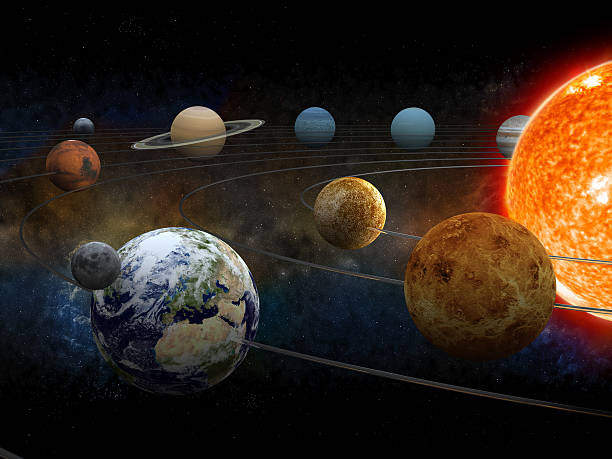General Solar System Trivia
Question: Which month throws a starry sky party every year called the Perseid meteor shower?
Answer: August
Question: What’s the cosmic limit for solar eclipses in one year before Earth says, “That’s enough drama”?
Answer: 5
Question: How long does it take for sunlight to slide into Earth’s DMs after leaving the Sun?
Answer: 8 minutes
Question: Which country is home to the massive Vredefort crater left behind by a space rock with no chill?
Answer: South Africa
Question: In what year did the Viking Lander become the first robot to touchdown on Mars like it owned the place?
Answer: 1976
Question: How many months on average do we wait between those epic total solar eclipse shows?
Answer: 18 months
Question: What’s the spacey term for when one celestial body does a “peek-a-boo” by crossing in front of another?
Answer: Transit
Question: What are those dark, moody spots on the sun’s surface that kinda look like interstellar pimples?
Answer: Sunspots
Question: What do you call a rebel planet that decided the solar system wasn’t big enough for it?
Answer: Exoplanet
Question: Oberon, Titania, and Miranda sound like a girl group—but which planet do they actually orbit?
Answer: Uranus
Planets Trivia
Question: Which planet is so extra it almost became a star but didn’t quite make the cut?
Answer: Jupiter
Question: What do you call a space rock that’s orbiting the Sun like it’s on a permanent road trip?
Answer: Asteroid
Question: What mysterious cosmic hole is born when a star collapses in on itself like a drama queen?
Answer: Black
Question: NASA's Cassini space probe went all in to study which planet and its glamorous rings?
Answer: Saturn
Question: Which fiery sky streak is basically a space rock burning up like it’s making a grand entrance?
Answer: Meteor
Question: Which planet has the bragging rights of hosting Ganymede, the solar system’s largest moon?
Answer: Jupiter
Question: Triton, the moon with attitude, belongs to which distant and chilly planet?
Answer: Neptune
Question: Which planet hangs out with two spooky-sounding moons named Phobos and Deimos?
Answer: Mars
Question: Which icy-blue world calls Triton its cosmic sidekick?
Answer: Neptune
Question: Who gets credit for having Triton as their biggest moon—no repeats, just the cold hard truth?
Answer: Neptune
Question: Which planet looks like it’s wearing a cosmic hula hoop all the time?
Answer: Saturn
Question: How many gas giants are vibing in our solar system’s outer neighborhood?
Answer: 2
Question: How many moons does Venus have, or is it flying solo like a space introvert?
Answer: 0
Question: Mars keeps two tiny moons in orbit—can you guess how many Martian sidekicks there are?
Answer: 2
Question: How many solid-surfaced “land lover” planets are hanging out in our solar system?
Answer: 4
Question: Which giant planet throws the biggest moon party with over 75 orbiting guests?
Answer: Jupiter
Question: Uranus is in no rush—it takes how many Earth years to make one lap around the Sun?
Answer: 84
Question: Which planet wins the title of coldest in the solar system’s ultimate freeze-off?
Answer: Uranus
Question: Which planet brings the heat with surface temps that could fry a pizza at 450°C?
Answer: Venus
Question: One year on Mercury is so short, it wraps up in how many speedy Earth days?
Answer: 88
Question: Which planet is the runner-up in size to tiny Mercury in the solar system’s small squad?
Answer: Mars
Question: Which planet spins so fast it’s basically the breakdancer of the solar system?
Answer: Jupiter
Space Exploration & Discovery Trivia
Question: What’s the space-age term for the man-made stuff floating around Earth like clutter in orbit?
Answer: Space Junk
Question: Which country took the first shot at Mars in 1960 with a probe named Marsnik 1?
Answer: USSR
Question: Which country said “Konnichiwa, Venus!” with its weather-watching Akatsuki mission?
Answer: Japan
Question: Which NASA mission boldly went to Pluto and beyond like a real-life space road trip?
Answer: New Horizons
Question: Which country is behind the iconic space paparazzi known as the Hubble Space Telescope?
Answer: United States
Question: The Hubble Space Telescope chills how many miles above Earth, snapping cosmic selfies?
Answer: 350 miles
Question: The Cassini-Huygens mission was a global team-up by NASA, the European Space Agency, and which pasta-loving country?
Answer: Italy
Question: In what year did the Hubble Space Telescope launch and forever change our view of the universe?
Answer: 1990
Question: NASA's Mars Curiosity Rover packed its bags for the Red Planet in which groundbreaking year?
Answer: 2011
Sun Trivia
Question: Which gas makes up a blazing 92.1% of the Sun, basically making it a giant ball of this element?
Answer: Hydrogen
Question: The Sun is kind of a big deal—what percent of the solar system’s total mass does it hog?
Answer: 99.80%
Question: Besides hydrogen, which gas is the Sun’s co-pilot in its fiery journey through space?
Answer: Helium
Question: How many Earths lined up could match the Sun’s colossal size—spoiler: it’s a lot?
Answer: 110
Question: What’s the Sun’s jaw-dropping diameter in kilometers—hint: it’s not something you’d drive across?
Answer: 1.4 million kilometers
Question: What powerhouse process fuels the Sun like an eternal nuclear engine?
Answer: Nuclear fusion
Question: What’s the name of the Sun’s outermost layer, also known as the crown that never comes off?
Answer: Corona
Question: The Sun’s surface sizzles at what average temperature in degrees Celsius—hot enough to toast anything?
Answer: Around 5,500 degrees Celsius
Question: How long does it take for sunlight to pull up to Earth’s doorstep after leaving the Sun?
Answer: About 8 minutes
Question: What fusion-powered process turns hydrogen into helium and lights up our solar system?
Answer: Nuclear fusion
Question: What’s the fancy name for the Sun’s “surface” that we can actually see from Earth?
Answer: Photosphere
Question: The Sun outweighs Earth by how much—think in terms of cosmic gym gains?
Answer: About 333,000 times the mass of the Earth
Question: How many little Earths could throw a party inside the Sun’s massive interior (with room to spare)?
Answer: Approximately 1.3 million Earths
Question: The Sun’s made mostly of which two besties from the periodic table?
Answer: Hydrogen and helium
Question: What do we call the Sun’s fiery tantrums that show up as sudden bright flashes?
Answer: Solar flare
Question: How old is the Sun, give or take a few million candles on its birthday cake?
Answer: Around 4.6 billion years
Question: What’s the name of the magnetic force field the Sun throws deep into space like a superhero cloak?
Answer: Heliosphere
Question: How long does it take for the Sun to spin once at its equator—think of it as a really slow dance?
Answer: About 25 days
Question: What’s the dramatic moment called when the Moon photobombs the Sun and blocks it completely from view?
Answer: Total solar eclipse
Astronomy Trivia
Question: In which century did astronomers spot the very first asteroid and go, “Wait, that’s not a star!”?
Answer: 19th
Question: Which year did Uranus crash the planet party and get discovered—without a telescope filter, mind you?
Answer: 1781
Question: What space invader is blamed for the dinosaur extinction—basically Earth’s ultimate “unfriend” moment?
Answer: Asteroid
Question: Planets in our solar system come in two flavors: Gas Giants and what rocky gang?
Answer: Terrestrial
Question: What word completes the icy region beyond Pluto—starts with Kuiper, ends with cosmic mystery?
Answer: Belt
Question: What’s the dreamy name for those glowing clouds of dust and gas where stars are basically born?
Answer: Nebula
Question: Galaxies come in a few shapes—how many main types are there in the cosmic design catalog?
Answer: 3
Question: Our galaxy has arms too—how many spiral arms does the Milky Way flex in space?
Answer: 4
Question: What do you call a chilly mix of gas, dust, and rock that zooms through space like a dirty snowball?
Answer: Comet
Question: Which planet doubles as the “morning star” even though it’s totally not a star?
Answer: Venus
Question: In what year did Pluto get kicked out of the planet club and join the dwarf squad instead?
Answer: 2006
Solar System Features Trivia
Question: What comes after 'Kuiper' in the name of a chilly region of space hanging out near Neptune?
Answer: Belt
Question: What comes after 'Swift' in the name of a comet that makes a rare VIP appearance every 133 years?
Answer: Tuttle
Question: What comes after 'Oort' in the name of a mysterious space zone way out on the solar system’s edge?
Answer: Cloud
Question: What’s the name of the icy outer shell of space objects beyond the Kuiper Belt—like the solar system’s frosty secret?
Answer: Oort Cloud
Comets & Asteroids Trivia
Question: Halley’s Comet is set to swing by for another Earth visit in which future year—mark your space calendars!?
Answer: 2061
Question: In which totally rad decade did Halley’s Comet last cruise past Earth like a celestial rockstar reunion tour?
Answer: 1980s
Question: The Kuiper Belt chills out beyond the orbit of which big blue outer planet?
Answer: Neptune
Question: The asteroid belt plays interplanetary traffic cop between Mars and which gas giant?
Answer: Jupiter
Moons Trivia
Question: Which planet wins the moon hoarding contest with 67 confirmed and named orbiting sidekicks?
Answer: Jupiter
Question: In which century did William Herschel look up and say, “Hey, that’s a whole new planet!” about Uranus?
Answer: 18th
Question: Which was the first planet to be officially discovered by scientists rather than ancient sky-watchers?
Answer: Uranus
Question: In what year was Jupiter’s famous Great Red Spot spotted—centuries before red flags were trendy?
Answer: 1665
Question: Which moon reigns as the biggest in the entire solar system, out-sizing even Mercury?
Answer: Ganymede
Question: What are the two tiny tagalongs that orbit Mars like cosmic bodyguards?
Answer: Phobos and Deimos
Question: Which fiery moon of Jupiter throws volcanic tantrums that put Earth’s volcanoes to shame?
Answer: Io
Question: Which Saturnian moon is rocking the only thick atmosphere in moon history?
Answer: Titan
Question: What’s the name of Neptune’s biggest moon, always showing up for the deep-space photo ops?
Answer: Triton
Question: Which moon of Uranus has a wild, tumbling rotation that says “rules are optional”?
Answer: Miranda
Question: Which moon of Saturn has a giant space-scar, a ridge running straight along its equator?
Answer: Iapetus
Question: Which moon of Jupiter is famous for being icy, mysterious, and a bit of an overachiever in surface style?
Answer: Europa
Question: What’s the name of Pluto’s ride-or-die moon that’s nearly half its size?
Answer: Charon
Question: Which icy moon of Saturn is out here shooting water jets into space like it’s got built-in geysers?
Answer: Enceladus
Question: Which moon of Neptune moonwalks backward through space with a rare retrograde orbit?
Answer: Triton
Question: What’s the name of the chonkiest moon orbiting Saturn—seriously, it’s thicc?
Answer: Titan
Question: Which dark and mysterious Uranian moon has a feature literally called “The Great Dark Spot”?
Answer: Umbriel
Question: What’s the name of the largest moon of Venus—wait, plot twist: does it even have one?
Answer: None (Venus does not have any moons)
Question: Which four famous moons of Jupiter were discovered by Galileo back in 1610 using a not-so-HD telescope?
Answer: The Galilean moons (Io, Europa, Ganymede, Callisto)
Miscellaneous Solar System Trivia
Question: Which planet is basically named after the original Roman goddess of love and glow-ups?
Answer: Venus
Question: How much gravity does the Moon have compared to Earth—enough for some sweet slow-motion jumps?
Answer: Sixth
Question: What’s the name of the invisible space “fence” that marks the end of our solar system’s backyard?
Answer: Heliopause
Question: How many days does it take the Moon to do one full lap around Earth—no shortcuts allowed?
Answer: 27.3
Question: Which country can claim Johann Bode, the astronomer who helped bring Uranus into the cosmic spotlight?
Answer: Germany

